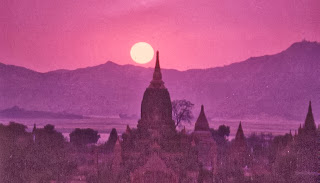 |
| Aidan Schmer in front of Chiang Dao Mountain |
Chiang Mai is undoubtedly one of the
best places in Northern Thailand to launch a trip out into the wild. For
paddling enthusiasts, Prisana and Eric Nuechterlein, kayaking down the Mae Ping
River during low water conditions turned
out to be a bit more exciting than they had anticipated.
By Prisana Nuechterlein
Chiang Mai - "Eddy out! Eddy out!"
shouted Aidan Schmer, our American kayaking guide. We were two hours into our
adventurous paddle, exploring the scenic Mae Ping River in northern Thailand
when suddenly Aidan’s urgent command broke the stillness surrounding us. Aside
from myself and my husband Eric, there were six other paddlers in our international
group, ranging in ages from mid-20s to mid-60s. All were novices, except for
Eric and I, but most of our experience had been acquired from many years of
ocean kayaking and not from river kayaking.
The older German couple paddling beside my husband and I looked perplexed. Perhaps they were wondering: “Who is this Eddie Out?” Their English was "not so good" and our German was nonexistent. I pointed over to the shore and paddled ahead toward the calmer pool of water, signaling for them to follow me. Behind me I heard a rush of exchanges and caught a familiar word "kaput", which obviously had the same meaning both in German and in English.
The older German couple paddling beside my husband and I looked perplexed. Perhaps they were wondering: “Who is this Eddie Out?” Their English was "not so good" and our German was nonexistent. I pointed over to the shore and paddled ahead toward the calmer pool of water, signaling for them to follow me. Behind me I heard a rush of exchanges and caught a familiar word "kaput", which obviously had the same meaning both in German and in English.
 |
| Eric and Prisana kayaking the River Ping |
Earlier in the morning Aidan (a
fluent German speaker born to German parents) had given us an informative kayak
briefing in English and in German, teaching us different maneuvers and kayaking
terminology. The highly experienced waterman had moved to Chiang Mai from
Hawaii about five years ago and began a booming bike touring business which
eventually included kayak tours. With 25 years of “coaching surface water
sports” under his belt, Aidan had learned that instructing novice paddlers how
to navigate a river was best done in a loud voice.
Our entry point was located about one
and a half hours north of Chiang Mai at a lush location in front of the famous
Chiang Dao Mountain. Known as the “last
tooth of the Himalayas", the jagged mountain ranks as Thailand's third
highest mountain. The Mae Ping River, known to locals as the “Lifeline of the
Province”, has its source in this mountainous region of Chiang Dao, located in
the northernmost point of Chiang Mai Province.
 |
| Kayaking in Northern Thailand |
Depending on the season and the volume
of water flow, the river can either be described as “imposing and mighty” or
“tranquil and meandering”. On this particular day, the water level was very low
causing some anxiety among our novice paddlers. During our safety briefing,
Aidan had instructed us to always keep our feet pointed downstream, should we
find ourselves flipped out of our kayaks. This warning would prove useful to
nearly all of us in the hours ahead.
We ventured forth, practicing our various training maneuvers. Our river guide Aay was the leader, while Aidan paddled toward the back of our string of bright kayaks. I followed practically in Aay’s shadow, benefiting from his close supervision especially when he taught me to point my kayak sideways as we entered the numerous twist and turns of the winding river. Far behind me, I heard Aidan shouting commands at a young man from Holland, who had gotten stuck on yet another boulder. In between the calm stretches of water, where we floated unobstructed, were far more challenging episodes of Man verses Rock accompanied by Aidan’s intimidating, but well meaning shouts.
We ventured forth, practicing our various training maneuvers. Our river guide Aay was the leader, while Aidan paddled toward the back of our string of bright kayaks. I followed practically in Aay’s shadow, benefiting from his close supervision especially when he taught me to point my kayak sideways as we entered the numerous twist and turns of the winding river. Far behind me, I heard Aidan shouting commands at a young man from Holland, who had gotten stuck on yet another boulder. In between the calm stretches of water, where we floated unobstructed, were far more challenging episodes of Man verses Rock accompanied by Aidan’s intimidating, but well meaning shouts.
 |
| Prisana shadowing river guide Aay |
My kayak bounced and banged up
against one boulder after another, but amazingly never flipped over. At one
point, I was stuck on a rock for a few brief moments, thankfully far from
Aiden’s line of sight. I struggled to remember what Aidan had told us during
our briefing, wondering if I should spin the kayak, or rock back and forth,
fearful of choosing the wrong option and gashing the bottom of his hard shell kayak
wide open. Fortunately, his sturdy kayak was tough enough to survive all of the
rock bashing, sliding and spinning rotations necessary to navigate the rocky
passages.
 |
| Thai River Guide Aay |
Inside a calm passage, we floated in
complete silence, breathing in the sweet serenity of river life. I laid back on
my kayak, blissfully enveloped by the sprawling jungle atrium of bird calls and
forest fauna shading the peaceful river. A natural by product and appeal of
paddling is the meditative Zen state that it produces. "If you're thinking
about what happened yesterday, or what will happen tomorrow, you will sadly miss
out on the magical experience of this trip today," Aidan said soon after
we launched. Recalling his advice, I glided along trying to focus only on the present
scene unfolding before me.
A few hours had passed, when I noticed what appeared to be a small dam downriver. Aidan paddled quickly by us and said something, but I only caught two words: “very important.” The German couple looked at me quizzically. Apparently, "very important" was all that they had heard as well, but none of us had a clue as to WHAT was important? No worries, we were four hours deep into our kayaking adventure and felt confident that our fearless leader would not lead us astray. We bravely forged ahead until we saw the couple from Holland abruptly stop in front of the dam, where Aidan was standing in the river prepared to guide them over the top of it.
A few hours had passed, when I noticed what appeared to be a small dam downriver. Aidan paddled quickly by us and said something, but I only caught two words: “very important.” The German couple looked at me quizzically. Apparently, "very important" was all that they had heard as well, but none of us had a clue as to WHAT was important? No worries, we were four hours deep into our kayaking adventure and felt confident that our fearless leader would not lead us astray. We bravely forged ahead until we saw the couple from Holland abruptly stop in front of the dam, where Aidan was standing in the river prepared to guide them over the top of it.
Usually I enjoy being the risk
taker and the first to try something, but watching the questionable maneuver
occurring in front of me, I was relieved not to be the first in line. The vertical
drop off from the dam was nearly five feet. I anxiously watched the Dutchman
flying off the edge of the dam, and to my relief he smoothly sailed over the spillway and perfectly landed his kayak below.
With Aidan’s help we conquered the dam and paddled a short distance to a secluded location along the river bank where we enjoyed a delicious Thai meal at a thatched roof, open air restaurant. The lifeline of Chiang Mai flowed onward without us, meandering through the vibrant countryside. For a few brief hours, we had escaped into what Aidan called the “edge of civilization” where the past and the future were replaced with only the rare sanctuary of present time.
With Aidan’s help we conquered the dam and paddled a short distance to a secluded location along the river bank where we enjoyed a delicious Thai meal at a thatched roof, open air restaurant. The lifeline of Chiang Mai flowed onward without us, meandering through the vibrant countryside. For a few brief hours, we had escaped into what Aidan called the “edge of civilization” where the past and the future were replaced with only the rare sanctuary of present time.
























